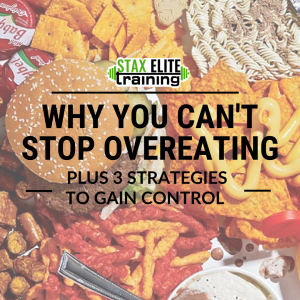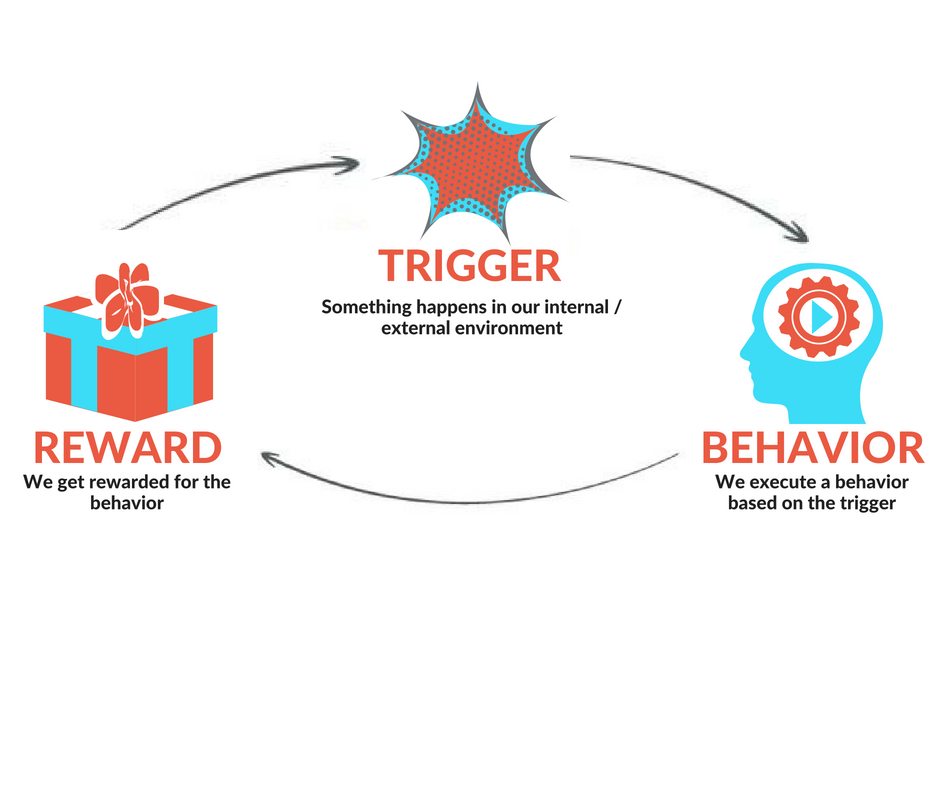
WE'VE ALL BEEN THERE BEFORE: 1 salty crunch turns into 100, and suddenly you’re elbows deep grabbing for that last cheese dusted puff at the bottom of the bag wondering: What’s wrong with me?
Believe it or not, it’s actually normal to feel like you can’t stop overeating certain things. Today’s overly processed food is creating a modern-day food crisis; one that’s leaving us feeling sick to our stomachs, out of control, and constantly craving more.
We’re letting you in on the secret most food manufacturers don’t want you to know:
Processed foods are scientifically engineered to be irresistible and easy to consume in large quantities. If you can’t stop, then the chips are doing their job.
Trust us, we’re annoyed by this junk food trickery too. So, we’re going to equip you with three useful strategies for exploring your relationship with processed food and taking control of overeating.
If you find that your out of control around certain processed foods, we promise you’re not crazy. At times, even the healthiest of eaters feel out of control around food. It can be extremely frustrating and discouraging if you show up to a backyard BBQ with the best of intentions to eat healthy so you bring a quinoa salad filled with fresh veggies and low-fat dressing, and instead you find yourself inhaling a plate of chips, cookies, and some high-fat barbecue lathered mac n’ cheese casserole thing that someone made.
Even with the best of intentions, the appeal of certain foods is so strong that it can leave us feeling helpless. If you’ve felt this before, Like we said, certain foods are actually meant to make us overeat.
TRUTH: There’s a whole industry dedicated to creating food that’s so tasty it’s basically irresistible.
Your body and brain are responding exactly as they’re supposed to. Believe it or not, it’s supposed to feel almost unnatural to stop eating these foods.
Reason being, processed foods are foods that have been modified from their original, whole-food form in order to change their flavor, texture, or shelf-life. Often times, they’re altered so that they hit as many pleasure centers as possible; from our brains to our mouths to our stomachs. They are highly crave-able, immediately gratifying, fun to eat, and easy to over-consume quickly (and often cheaply).
Processed foods will also look and feel different from their whole food counterparts, depending on the degree that they’re processed.
Let’s take corn as an example since it’s one of the most commonly processed foods.
When corn is boiled and eaten off the cob it’s pale yellow, chewy and delicious.
Corn that’s been a little processed — turns into a soft corn tortilla. A tortilla has a nice corny flavor and a soft, bendable texture that makes it easy to eat and digest.
But what if that corn is ultra-processed? You remove all the fiber, isolate the starch, and then use that starch to make circular-shaped chips, which are fried and dusted with a sweet and salty mystery powder. And they’re annoyingly delicious.
ALSO TRUE: There are four sneaky ways processed food can make you overeat. Often, we’re not even aware of how much these factors affect us, which is why we’re letting you in on these sneaky ways because awareness = power. Here they are:
1. MARKETING & ADVERTISEMENTS CONVINCE US THAT PROCESSED FOODS ARE "HEALTHY"
Processed foods come in packages with bright colors, energetic cartoon characters, celebrity endorsements, and powerful words that trigger all kinds of positive associations.
Processed foods that contain health buzzwords like organic, vegan, and gluten-free on their label are there to create an illusion of health around them.
Companies come out with organic versions of their mac n' cheese, gluten-free versions of their sugar-dusted pastries, and vegan versions of their icing covered cinnamon rolls.
You’ll see chips “prepared with avocado oil,” sugary cereal “made with flaxseed,” or creamy chip dip with “real spinach.”
If you examine the nutrient content of those foods you’ll notice it isn’t very impressive, but the addition of nutrition buzzwords and trendy ingredients trick us into thinking they’re healthier than they really are.
2. LARGE PORTIONS FOR A SMALL PRICE MAKE US THINK WE'RE GETTING A "GOOD DEAL"
People get confused about food and value. We’re taught to save money and not waste food. We’re taught to buy more for less.
What we don’t calculate into this equation is something we refer to as a “health tax.”
The “health tax” is the toll you pay for eating low-nutrient, highly processed foods. If you eat them consistently over time, eventually you’ll pay the price with your health.
When companies use cheap, poor quality ingredients, they can sell bigger quantities without raising the price.
Sure, you’ll save a buck or two in the short term, but you’ll pay the health tax in the long term.
3. MORE VARIETY = MORE HUNGRY
Having a variety of choices is exciting to most people.
Think of a self-serve frozen yogurt topping bar:
“Ooh Sprinkles! And gummy bears! Oh, and those mini peanut butter cups! And granola clusters! Wait, are those crushed cookies?? And cheesecake chunks??! YES! Now on to the drizzles…”
Before you know it, there’s a party of processed foods rocking out to Taylor Swift on your frozen yogurt in front of you.
Or think of those “party mixes” — pretzels and corn chips and cheesy puffs and barbecue rings — all in one bag. The fun never ends because there’s a variety of flavors and textures to amuse you forever!
When we have lots of variety, we have lots of appetite.
It’s hard to overeat tons of one thing, with one flavor, like apples.
How many apples can you eat before, frankly, you get bored?
Reduce the variety and you also reduce distraction from your body’s built-in self-regulating signals. When we’re not so giddy with choice and stimuli, we’re more likely to slow down, eat mindfully, and eat less.
4. A COMBINATION OF FLAVORS IS IRRESISTIBLE
- Sugar
- Fat
- Salt
These three flavors — the sweetness of sugar, the palatable mouthfeel of fat, and the sharp savory of salt are an irresistible combination.
Separately, a spoonful of sugar, or salt, or vegetable oil doesn’t sound that appetizing, but when you combine these flavors, they become very hard to resist.
This is called stimuli stacking — combining two or more flavors to create food that is irresistibly appealing.
Food manufacturers know: When it comes to encouraging people to overeat, two flavors are better than one.
And if you’re relying on willpower to resist these foods, you’re fighting an uphill battle.
The solution isn’t more willpower. The solution is educating yourself about these foods, examining your own relationship with food, and employing strategies that put you in control.
HERE'S 3 STRATEGIES TO BUILD A PEACEFUL RELATIONSHIP WITH FOOD:
It’s one thing to know in theory why certain foods are so easy to over-consume, but it’s even more valuable to discover for yourself how food processing, certain ingredient combinations, marketing, and even easy accessibility affect you and your food choices.
1. GET CURIOUS ABOUT WHAT YOU'RE PUTTING IN YOUR MOUTH
We’ve established that processed foods are designed to be easy to eat.
For a food to be “easy to eat”, it has to be:
-broken down easily (less chewing), and
-low volume (doesn’t take up much physical space).
So:
Less chewing + Low volume = More eating
Chewing takes time. The more we have to chew something, the longer it takes us to eat, giving our fullness signals a chance to catch up.
That feeling of “fullness” matters a lot too.
When you eat, your stomach expands. It’s partly through that sensation of pressure that your body knows you’ve had enough. Processed foods deliver a lot of calories without taking up much space, meaning you can eat a lot before you realize you’ve overdone it.
EXPERIMENT #1: OBSERVE & CHEW
We want you to count your chews.
Note: Don’t do this forever. We’re not trying to turn you into the weirdo that no one wants to sit next to at the lunch table. Just try it as an experiment to get some data about how you eat different foods.
First, eat a whole food — a vegetable, fruit, whole grain, lean protein, whatever — and count how many chews you take per mouthful. How long does it take to eat an entire portion of that food? How satiated do you feel afterward? Do you want to eat more?
Then, next time you eat something processed, count how many chews you take per mouthful. How long does it take to eat that serving of pasta, chips, or cookies? How satiated do you feel afterward? Do you want to eat more?
Make some comparisons and notice the differences. Contrast how long eating each of these foods takes you, how satiated you feel after eating each of them, and how much you want to keep eating.
How will you use that information to make food choices moving forward?
2. DON'T LET MARKETING STRATEGIES FOOL YOU
Food manufacturers use creative marketing strategies to suggest that processed foods are healthy. And even if you know they’re not, they have other ways of getting you to buy them.
Here’s an example:
Have you ever noticed that the produce section is the first area you pass through in a grocery store?
NEWS FLASH: This isn't a coincidence! Grocery stores have found that if they put the produce section first, you’re more likely to purchase processed foods. Reason being, if you’ve already got your cart loaded with spinach, broccoli, and apples, maybe you’ll feel better about picking up some ice cream, cookies, and chips, before heading to the checkout line.
Let that sink in: The supermarkets we all shop in several times a month are designed to make you feel better about buying foods that could negatively impact your health goals.
The good news? Simply being aware of this trick can help you bypass it.
EXPERIMENT #2: TAKE A CLOSER LOOK IN YOUR PANTRY
In this experiment, you’ll examine the foods you have in your home and the messages you’ve been given about them.
Note: Keep in mind that this is a mindful awareness activity. You’re not doing this to judge yourself or feel shame about the food choices you’ve made.
Look at your pantry with curious (and more informed) eyes.
• Step 1: Look for falsely labeled “health” foods. Do you have any? If so, why did you choose them? Was it the language used to describe it? Was it the packaging? A trendy “superfood” ingredient? Is it organic, gluten-free, sugar-free, Paleo, or something else?
• Step 2: Read the nutritional information. Once you’ve identified the falsely labeled health foods, take a closer look. Is your “healthy” organic dark chocolate peanut butter cup all that nutritionally different from that mass-market peanut butter cup? Chances are, it’s just different packaging.
• Step 3: Count how many varieties of junk foods you have. If you love ice cream — how many flavors do you have? If you peek into your cupboards, are there cookies, popcorn, candy, or chips? Without judgment, count the total junk food variety currently in your home. Generally, the more options you have, the easier it is to overeat.
The takeaway?
You’ll be more aware of the particular types of marketing you’re susceptible to, which you can use to make more informed food choices.
You’ll also have a better idea of which treat foods you prefer, and by reducing the variety of them in your home, you’ll cut down on opportunities to overeat.
3. BE AWARE OF PATTERNS
We often use food for reasons other than physical nourishment.
For example, if we feel sad, we might reach for a cookie to comfort ourselves. Temporarily, we feel better. The next time we feel sad, we remember the temporary relief that cookie brought us. So, we repeat the action. If we continue to repeat this cycle, we may find our arm reaching for the cookie jar every time we feel down. We’re not even thinking about it at this point; it’s just habit. Habits are powerful, for better or for worse. They can work for us or against us. Luckily, we have control over this. All it takes is a little time and an understanding of how habits get formed.
All animals learn habits in the following way:

EXPERIMENT #3: PUT YOUR HABITS TO WORK
If you want to break the habit of overeating, you can use this trigger, behavior, and reward loop to your advantage. Here’s how.
Step 1: Figure out what your triggers are
A trigger can be a:
- Feeling. We might eat more when we’re stressed, lonely, or bored. Food fills the void.
- Time of day. We always have a cookie at 11am, or a soda at 3pm. It’s just part of our routine.
- Social setting. Hey, everyone else is having beer and chicken wings, so might as well join the happy hour!
- Place. For some reason, a dark movie theater or our parents’ kitchen might make us want to munch.
- Thought pattern. Thinking “I deserve this” or “Life is too hard to chew kale” might steer us toward the drive-thru window.
When you find yourself eating when you’re not physically hungry, increase your awareness of your triggers by asking yourself:
- What am I feeling?
- What time is it?
- Who am I with?
- Where am I?
- What thoughts am I having?
Keep a journal and look for patterns.
And remember: Overeating is generally problematic when it’s chronic — those pants are feeling pretty tight after most meals — or when episodes of overeating are particularly intense, like during a binge. So, don’t get too worried with isolated episodes of overeating.
Step 2: Try associating new behaviors with your trigger(s)
Once you’ve identified your triggers, try associating new behaviors with them. These should support your health goals and feel good. If the new behaviors aren’t rewarding, they won’t be repeated, so they won’t be learned as habits.
In order to find the “right” new behavior, it’s helpful to know that when we eat, we’re trying to meet a “need.”
So, when you brainstorm new behaviors, find something that meets that need — be it time in nature, some human connection, a physical release, or just a break from your thoughts.
Step 3: Practice makes perfect
Every time a trigger pops up that compels you to eat, replace eating with a healthy feel-good behavior.
Repeat this loop until the new behavior becomes a habit that’s just as automatic as reaching for the jar of peanut butter used to be.
If you made it to this point, give yourself a pat on the back! We hope you'll utilize these strategies and help yourself build some new healthy behaviors that turn into habits that set you up for success!



